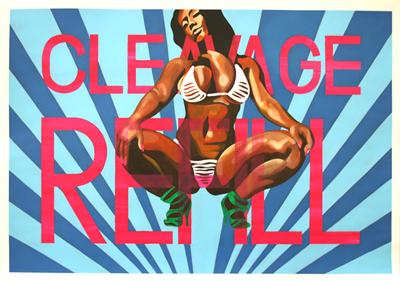Want to get your music out to over 40k radio and sound system dis? CLICK HERE
Stay up-to-date with all that's new at Dancehallreggaeworld, Click Here to subscribe for my updates and don't miss a thing!
Dancehall Party Inspired Art
by Robin Clare
(Sydney, Australia)

Cleavage Refill, Acrylic on Paper, 100cm x 70cm
Hi,
My name is Robin Clare and I'm a Jamaican artist currently living in Australia. I've recently been seeking my artistic inspiration from dancehall music and the Jamaica party scene which I love getting into when I go back home.
I've recently been working on two series of paintings titled 'Jamaica Project' and 'Dancing Words'. They both borrow from and take inspiration from party names and dance styles, tag lines and the variety of imagery that surrounds the scene as a whole with a few Jamaican pop icons added in.
I have images from the project on my website at
Jamaica Project: http://www.robinclare.com/Jamaica%20Project.htm
Dancing Words:
http://www.robinclare.com/Dancing%20Words.htm
Ihope you find them interesting and look forward to hearing your thoughts.
Best wishes,
Robin Clare
Below is my official statement on the Jamaica Project series:
Jamaica Project explores the way in which modern Jamaica expresses itself through its dancehall and party culture. The result is a combination of purely text-based work alongside sexually suggestive graphics inspired by imagery that surrounds the scene.
The work shows a culture where women are highly sexualised within a very male dominated dancehall and party scene. An interesting commentary on the dichotomy of Jamaican women's place within a society which often expects women to maintain roles as both breadwinner and sex object.
My chosen method to base my painting style on is directly inspired by traditional Jamaican artisan skills. Specifically focusing on hand painted signage used in advertising. As you travel around the island you can see hand painted signage on walls, bus shelters and entire sides of buildings with a variety of messages ranging from selected goods you can buy at local supermarkets and hardware stores to advertising for local law firms and go-go clubs.
Yet with cheap costs of production modern digitally produced advertisements are fast becoming a dominant form of written and visual communication in Jamaica, enabling a transformation in the way the culture is shaping its messages and portraying itself to the world. With this homage to sign painting which may one day become a thing of the past, I can recognising the endeavour and skill that went into this past production and that which goes into the present.
Combining my technique with messages
Having grown up in Jamaica and lived abroad for many years I have an outsider’s perspective of the current culture allowing me the vantage point to reflect on how new more modern forms of media are enabling a thriving party scene to express and advertise itself in ever more creative ways to an ever expanding audience and shaping Jamaica's global brand.
The party scene in Jamaica reflects a culture that recognises that humour is necessary to get through life. Of key importance are the often-outrageous names and tag lines that are used to draw an audience. Jamaican party names are in your face and chauvinistic with titles like ‘Cleavage Refill’ and ‘Wet Dreams’ infused with tongue and cheek phrases and schoolboy double entendre. They are accompanied by images of scantly clad women in various alluring poses, reminiscent of 70’s American porn.
These party advertisements are a common sight around town with taxi drivers displaying text only versions in tinted back windows, whilst blaring the latest dancehall tunes. While image heavy posters and flyers float around town.
My paintings examine this party culture that seems at odds with Jamaica’s traditional conservative and religious moral outlook. The society prides itself on its family values and has a huge and very active array of different religions and churches on offer.
It can also be said that Jamaican society is driven by its’ women. Women are more likely to continue through to secondary education and are often at times left to support large and extended families while the men come and go.
Consequently women end up being the major breadwinners, yet they are portrayed and appear to allow themselves to be portrayed as sex objects within a very male dominated society. My work reflects this tempestuous balance of opposites which all plays out within the party scene and finally on the dancehall floor.
Want to learn more about Reggae Music? check these pages below...
New! Talk to me
Was the information helpful? Something needs changing? I welcome your feedback here.
Great Articles You Might Have Missed
Please send us your Feedback, News, Photos, Press Releases, Music and/or Videos to our WhatsApp Number: 1-876-395-8008 or Email: necoflex@gmail.com
Not what you are looking for? Search the web for more Dancehall Reggae music information below...














